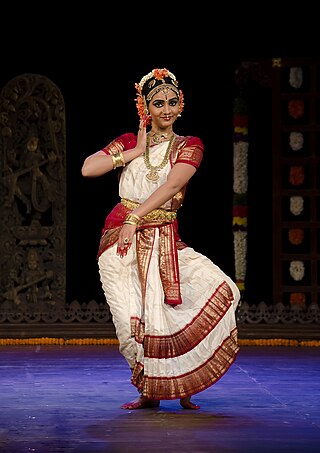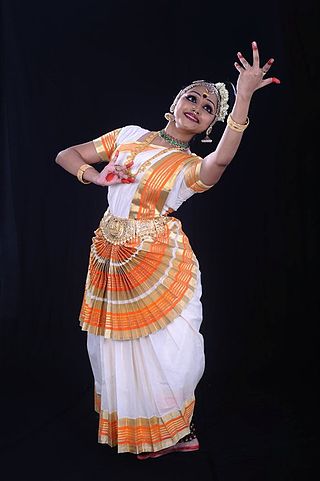
Karanas are the 108 key transitions [1] in the classical Indian dance described in 4th Chapter named "Tandava Lakshana" of Natya Shastra. Karana is a Sanskrit verbal noun, meaning "doing".

Karanas are the 108 key transitions [1] in the classical Indian dance described in 4th Chapter named "Tandava Lakshana" of Natya Shastra. Karana is a Sanskrit verbal noun, meaning "doing".
Natya Shastra states that Karanas are the framework for the "margi" (pan-Indian classical) productions which are supposed to spiritually enlighten the spectators, as opposed to the "desi" (regional folk or pop dance) productions which can only entertain the spectators. "One who performs well this Karana dance created by Maheswara will go free from all sins to the abode of this deity," states Natya Shastra [2]

Some of the well-known interpretations of karanas are by Padma Subramanyam that were based on 108 brief movement phrases describing specific leg, hip, body, and arm movements accompanied by hasta mudras described in the Natya shastra and other scriptures, and from depictions of the movements in sculpture in five South Indian temples, notably the Chidambaram temple which contains depictions of the full set. Padma Subrahmanyam has written a book called Karanas-Common dance codes of India and Indonesia, based on her research of karanas from the temples of Prambanan(Indonesia), Thanjavur, Kumbakonam, Chidambaram, Thiruvannamalai, and Vriddhachalam. In the 20th century, she was the first dancer to reconstruct the Karanas as movements, which were considered mere poses earlier.
Some other Bharatanatyam gurus, such as Adyar Lakshman (Kalakshetra school), as well as the Kuchipudi gurus Vempati Chinna Satyam and C.R.Acharya have also attempted to reconstruct all the 108 karanas, which were often significantly different from Padma Subrahmanyam's interpretations so much so that even on the chari (leg movement) level there was no agreement as to whose interpretation is correct. [ according to whom? ] Due to the significant variations in the depictions, most traditional Bharatanatyam schools considered Padma Subrahmanyam's style, which incorporated Karanas as incorrect, which forced her to name her own style as Bharatanrityam rather than Bharatanatyam. Many of Padma Subrahmanyam's disciples, such as Bala Devi Chandrashekar (SPNAPA Academy of performing arts) - Sujatha Mohan (Padmashree Nrithyalaya), Uma Sriram, Jayashree Rajagopalan, Dominique Delorme (France) and others are teaching the 108 karanas based on Subramanyam's research.[ citation needed ]
There used to be[ when? ] devadasis who performed all the 108 karanas. Still, now in most contemporary Bharatanatyam or Odissi schools, only a small number of karanas and their derivatives have been transmitted by parampara up to date.
Apart from that, performing of the same Karana differs greatly across different classical Indian styles. Currently, as regards the exact technique, there are no established standards and no universally agreed-upon interpretations of the texts and sculptures.[ citation needed ]

Nataraja, also known as Adalvallan, is a depiction of Shiva, one of the main deities in Hinduism, as the divine cosmic dancer. His dance is called the tandava. The pose and artwork are described in many Hindu texts such as the Tevaram and Thiruvasagam in Tamil and the Amshumadagama and Uttarakamika agama in Sanskrit and the Grantha texts. The dance murti featured in all major Hindu temples of Shaivism, and is a well-known sculptural symbol in India and popularly used as a symbol of Indian culture, as one of the finest illustrations of Hindu art. This form is also referred to as Kuththan, Sabesan, and Ambalavanan in various Tamil texts.

Bharatanatyam is an Indian classical dance form that originated in Tamil Nadu, India. It is a classical dance form recognized by the Sangeet Natak Akademi, and expresses South Indian religious themes and spiritual ideas of Hinduism and Jainism.

Kuchipudi is one of the eight major Indian classical dances. It originates from a village named Kuchipudi in the Indian state of Andhra Pradesh. Kuchipudi is a dance-drama performance, with its roots in the ancient Hindu Sanskrit text of Natya Shastra. It developed as a religious art linked to traveling bards, temples and spiritual beliefs, like all major classical dances of India.

Odishi, also referred to as Orissi in old literature, is a major ancient Indian classical dance that originated in the temples of Odisha – an eastern coastal state of India. Odissi, in its history, was performed predominantly by women, and expressed religious stories and spiritual ideas, particularly of Vaishnavism through songs written and composed according to the ragas & talas of Odissi music by ancient poets of the state. Odissi performances have also expressed ideas of other traditions such as those related to Hindu deities Shiva and Surya, as well as Hindu goddesses (Shaktism).
Arts and architecture in India have had their course shaped by a synthesis of indigenous and foreign influences that have consequently shaped the course of the arts of the rest of Asia, since ancient times. Arts refer to paintings, architecture, literature, music, dance, languages and cinema. In early India, most of the arts were derived Vedic influences. After the birth of contemporary Hinduism, Jainism, Buddhism, and Sikhism arts flourished under the patronage of kings and emperors. The coming of Islam spawned a whole new era of Indian architecture and art. Finally the British brought their own Gothic and Roman influences and fused it with the Indian style. They have a culture infusion in their art.

Mohiniyattam is an Indian classical dance form originating from the state of Kerala. The dance gets its name from Mohini – the female enchantress avatar of the Hindu deity Vishnu, who helps the devas prevail over the asuras using her feminine charm.

Indian classical dance, or Shastriya Nritya, is an umbrella term for different regionally-specific Indian classical dance traditions, rooted in predominantly Hindu musical theatre performance, the theory and practice of which can be traced to the Sanskrit text Natya Shastra. The number of Indian classical dance styles ranges from six to eight to twelve, or more, depending on the source and scholar; the main organisation for Indian arts preservation, the Sangeet Natak Academy recognizes eight: Bharatanatyam, Kathak, Kuchipudi, Odissi, Kathakali, Sattriya, Manipuri and Mohiniyattam. Additionally, the Indian Ministry of Culture includes Chhau in its list, recognising nine total styles. Scholars such as Drid Williams add Chhau, Yakshagana and Bhagavata Mela to the list. Each dance tradition originates and comes from a different state and/or region of India; for example, Bharatanatyam is from Tamil Nadu in the south of India, Odissi is from the east coast state of Odisha, and Manipuri is from the northeastern state of Manipur. The music associated with these different dance performances consists many compositions in Hindi, Malayalam, Meitei (Manipuri), Sanskrit, Tamil, Odia, Telugu, and many other Indian-Subcontinent languages; they represent a unity of core ideas and a diversity of styles, costumes, and expression.

Dance in India comprises numerous styles of dances, generally classified as classical or folk. As with other aspects of Indian culture, different forms of dances originated in different parts of India, developed according to the local traditions and also imbibed elements from other parts of the country.

Tandava, also known as Tāṇḍava Natyam, is a divine dance performed by Hindu god Shiva. Shiva is depicted as dancing the Tandava in his form of Nataraja.

Padma Subrahmanyam, is an Indian classical Bharata Natyam dancer. She is also a research scholar, choreographer, teacher, Indologist and author. She is famous in India as well as abroad; several films and documentaries have been made in her honor by countries such as Japan, Australia and Russia. She is well known as the developer and founder of the dance form Bharata Nrithyam.

Mungara Yamini Krishnamurthy is an Indian dancer of Bharatanatyam and Kuchipudi styles of dancing.

Classical Indian musical theatre is a sacred art of the Hindu temple culture. It is performed in different styles.
T.N. Ramachandran was an Indian art historian, artist, archaeologist and a Sanskrit scholar, specialising in the study and exposition of various aspects of Indian art. He was born to Narayanan & Visalakshi. He was the author of several monographs, and was the director-general of archaeology in India. He conducted research and wrote extensively on various subjects during his tenure as curator of archaeology at the National Museum, New Delhi.
Vempati Chinna Satyam was an Indian dancer and a guru of the Kuchipudi dance form.

Smitha Rajan is an Indian Mohiniyattam performer from Kerala and granddaughter of the Indian classical dancers Padma Shri Kalamandalam Krishnan Nair and Kalamandalam Kalyanikutty Amma.
Bala Devi Chandrashekar is a Bharatanatyam dancer and teacher based in Princeton, New Jersey, United States. She was trained under Dr. Padma Subrahmanyam. Bala Devi Chandrashekar is a Professor of practice in Asian performing arts. Her approach is interdisciplinary, involving lecturing and research. Bala Devi's unique well researched productions include Nandanar Charithram, Krishnaarpnam and Uddhava Gita.

Parshwanath Upadhye is an Indian classical dancer, choreographer and teacher. He is trained in the traditional Mysore style of Bharatanatyam.
Madras Kadiravelu Saroja, known as Puliyur Saroja, was an Indian classical dancer, known for her expertise, as an exponent and as a teacher, in the classical dance form of Bharatanatyam. The Government of India honored her, in 2011, with the Padma Shri, the fourth highest civilian award, for her services to the field of art and culture.
Meenakshi Chitharanjan, an Indian classical dancer, teacher and choreographer, is known as an exponent of the Pandanallur style of the classical dance form of Bharatanatyam. She is the founder of Kaladiksha, an institution promoting Bharatanatyam and striving to preserve the Pandanallur tradition. A disciple of the father-son duo of Chokkalingam Pillai and Subbaraya Pillai, she is a recipient of several honours including Kalaimamani Award of the Government of Tamil Nadu and the Natya Kala Sarathi of Sri Parthasarathy Swami Sabha. The Government of India awarded her the fourth highest civilian honour of the Padma Shri, in 2008, for her contributions to classical dance.
Bhagavata Mela is a classical Indian dance that is performed in Tamil Nadu, particularly the Thanjavur area. It is choreographed as an annual Vaishnavism tradition in Melattur and nearby regions, and celebrated as a dance-drama performance art. The dance art has roots in a historic migration of practitioners of Kuchipudi, another Indian classical dance art, from Andhra Pradesh to the kingdom of Tanjavur.